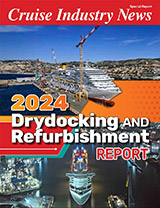Seaware AB announces an upgrade for its Seaware Routing software, introducing cost-based ship route optimization with capability of optimizing even short sea passages with high accuracy.
The Seaware Routing software is designed to facilitate on board weather presentation and ship route planning, and is delivered as part of weather routing solutions from Seaware partners, according to a press release from the company, which claims its software is the most advanced on the market, delivering fuel and cost savings potential.
Seaware Routing version 5 has been developed with special attention to optimization of short sea passages. During this work, the code for route optimization and performance predictions has been further refined, among other things by inclusion of a ‘virtual rpm regulator’ emulating the real-world engine control system.
“With the new upgrade our software can find the optimum route that will save you fuel and still take you to your destination within minutes from the preferred arrival time,” said Anders Olander, executive director of Seaware.
Systematic simulations using the upgraded software indicate cost savings potential. Especially in complex weather situations more than 20 percent fuel could have been saved by adopting the proposed route from the Seaware program instead of using the “standard route,” the company said.
Seaware Routing version 5 features cost-based route optimization, i.e. the objective during optimization is to minimize the total cost of a specific voyage.
By including fuel cost, daily cost for ship and crew, and also costs related to not arriving to the destination in due time, the program can be used to find the optimum route based on the user’s specific needs in different situations: Lowest cost route arriving at a fixed time; the route with lowest fuel cost and emissions; the fastest route; and lowest overall cost using user’s cost figures, offset from desired arrival time is allowed
“The fastest route is quite easy to identify, most competing software only supply this optimization alternative. The other priorities require a much more sophisticated or scientific approach”, said Seaware R&D Manager Mikael Palmquist.
A distinctive Seaware feature is the use of a physics-based model for the performance calculations. The company claims that their methodology is superior to the commonly used ‘speed down matrix’ concept found in competing software.
“The speed down matrix concept relies on user observations of ship speed in different weather conditions, and the accuracy of the method itself will not be better than the accuracy of the user data,” Palmquist added.
“Further, there is no established relation between speed, power and fuel consumption. This means that fuel consumption can only be treated approximately, based on running hours, leaving out the significant effects of increased power requirement and hence fuel consumption in bad weather”.
The Seaware performance model is developed in-house by Seaware naval architects, and describes the ship’s speed-power relation both in calm seas but also when the ship is exposed to wind and waves. It takes ship specific data including loading condition as input.



